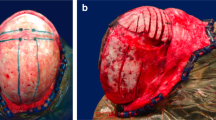Abstract
The standardized bilateral fronto-orbital advancement method of osteotomy established at the University of Wuerzburg is applied in all forms of craniosynostosis except scaphocephalus. The intention behind early operation is to halt progression of the disorder and to institute the physiological direction that growth should take. The preoperative severity of the disorder, the particular symptoms of the various malformations concerned, and the postoperative course of growth were analyzed and assessed both clinically and cephalometrically using the retrospective evaluations of the file data of 131 children with various forms of craniosynostosis. In contrast to linear craniectomy and so-called lateral canthal advancement, which have sometimes been thought to lead to undesirable postoperative growth development, only 11 relapses requiring renewed operation were found postoperatively in our own study of 131 children. It became evident that the greater the severity of the malformation, the more probable it was that a relapse would occur. Fronto-orbital advancement can only affect the pathologic growth pattern to a limited degree, especially when craniosynostosis is related to a syndrome. Cephalometric evaluation confirmed the limited potential for growth in the area of the anterior skull base and in the mid-face in the presence of syndrome-related brachycephaly and severe facio-craniosynostoses. In such clinical cases, compensatory growth of maxillary hypoplasia cannot be expected after fronto-orbital advancement.
Similar content being viewed by others
References
Albin RE, Hendee RW, O'Donnel RS, Majure JA (1985) Trigonocephaly: refinements in reconstruction. Experience with 33 patients. Plast REconstr Surg 76: 202–209
Broadbent BH Sr, Broadbent BH Jr, Golden WY (1975) Bolton standards of dentofacial development growth. Mosby, St Louis
Hasund A (1973) Klinische Kephalometrie für die Bergen-Technik. Thesis, University of Bergen
Kreiborg S (1986) Postnatal growth and development of the craniofacial complex in premature synostosis. In: Cohen MM (ed) Craniosynostosis: diagnosis, evaluation and management. Raven Press, New York, pp 157–189
Marchac D (1978) Radical forehead remodelling for craniostenosis. Plast Reconstr Surg 61: 823–835
Marchac D, Renier D (1985) Craniofacial surgery for craniosynostosis improves facial growth: a personal case review. Ann Plast Surg 14: 43–46
Mühling J (1986) Zur operativen Behandlung der prämaturen Schädelnahtsynostosen. Thesis, University of Würzburg
Mühling J, Reuther J, Sörensen N (1986) Problems with lateral canthal advancement. Child's Nerv Syst 2: 287–289
Mühling J, Sörensen N, Albert F, Collmann H, Zöller J (1994) Kraniofaziale Chirurgie im Kindesalter. Dtsch Ärztebl 91: 1915–1918
Ousterhout DK, Melsen B (1982) Cranial base deformity in Apert's syndrome. Plast Reconstr Surg 69: 254–263
Persing JA, Babler WJ, Nagorsky MJ, Edgerton MT, Jane JA (1986) Skull expansion in experimental craniosynostosis. Plast Reconstr Surg 78: 594–603
Persson M (1973) Structure and growth of facial sutures. Odontol Rev 24 [Suppl 26]: 1–146
Shillito J, Matson D (1968) Craniosynostosis—a review of 519 surgical patients. Pediatrics 41: 829–853
Tessier P (1967) Osteotomies totales de la face: syndrome de Crouzon, syndrome de l'Apert, oxycéphalies, scaphocéphalies, turricéphalies. Ann Chir Plast 12: 273
Tulasne JF, Tessier P (1981) Analysis and late treatment of plagiocephaly. Unilateral coronal synostosis. Scand J Plast Reconstr Surg 15: 257–263
Whitaker LA, Bartlett SP, Shut L, Bruce D (1987) Craniosynostosis: an analysis of the timing, treatment and complications in 164 consecutive patients. Plast Reconstr Surg 80: 195–206
Author information
Authors and Affiliations
Rights and permissions
About this article
Cite this article
Reinhart, E., Mühling, J., Michel, C. et al. Craniofacial growth characteristics after bilateral fronto-orbital advancement in children with premature craniosynostosis. Child's Nerv Syst 12, 690–694 (1996). https://doi.org/10.1007/BF00366152
Issue Date:
DOI: https://doi.org/10.1007/BF00366152




